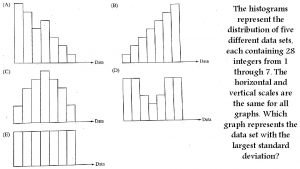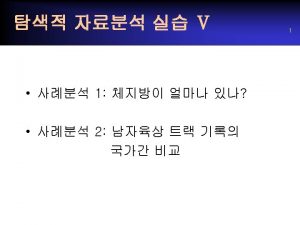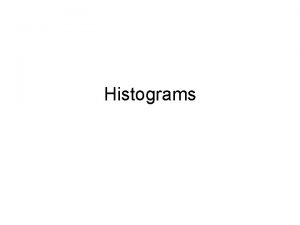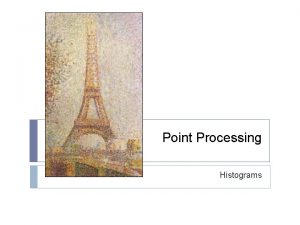Histograms Histograms A histogram is similar to a







- Slides: 7

Histograms

Histograms A histogram is similar to a bar chart expect the bars a joined together, thus it is typically used to represent continuous data in class intervals. Since adjacent classes share a line between bars it is best to use CLASS BOUNDARIES (rather than limits) on the horizontal axis. Class boundaries (used on the “shared” lines) Additionally unlike bar charts: each bar in a histogram may have varying widths and it is the AREA of a histogram that represents the FREQUENCY not the height.

Drawing Histograms Case 1: When the Class Widths are equal, each bar will have the same width. In this case, since the area is directly proportional to the height, the height can be used as the measure of frequency (ie frequency can be placed on the vertical axis) FREQUENCY The MODAL CLASS is the class with the HIGHEST BAR, in this case, the HIGHEST FREQUENCY CLASS BOUNDARIES

Drawing Histograms Example 1: (below) All class intervals are the same, so the bars of the histogram will all have equal width, and the frequency can be plot on the vertical axis MODAL CLASS ESTIMATED MODE

Drawing Histograms Case 2: When the Class Widths are UNequal, bars will have varying widths. Example 2 This graph is misleading!!! Because the first class has the largest class width, and the area of th 1 e first bar is so great, it leads one to believe that most flowers were <1. o m and this is not the case.

Drawing Histograms Case 2: When the Class Widths are UNequal, bars will have varying widths. So in this case, since the area is NOT directly proportional to the height, INSTEAD of frequency being plot on the vertical axis, FREQUENCY DENSITY is plot instead. “Frequency Density” looks at the density in relation to how wide the class is. It is calculated as: FREQUENCY DENSITY The MODAL CLASS is the class with the HIGHEST BAR, in this case, the HIGEST FREQUENCY DENSITY (not the highest frequency) CLASS BOUNDARIES

Drawing Histograms MODAL CLASS Class with highest frequency density not the one with the highest frequency ESTIMATED MODE













